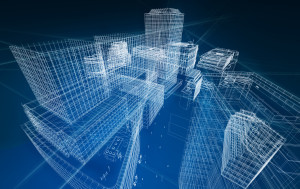Traditionally, contractors only base their project estimations on 2D drawings, which can be time consuming to takeoff and have the potential of missed scope due to the takeoff being broken over multiple sheets or the changes not being “clouded” in the newly issued documents. To tackle such challenges, estimating teams are now beginning to use a combination of 2D and 3D takeoffs. Companies that use a combination approach tend to have a competitive edge due to the vast benefits a model provides.
Here are the three reasons why you should combine 2D-based estimating with model-based estimating:
- Model-based estimates are more accurate. An accurate estimate can be the difference in winning or losing work. 3D model-based estimating allows you to easily visualize quantities in
 3D to understand scope, complexity and design intent to create a more accurate estimate. In a project, change is constant and the opportunities for the estimate to get off track are endless when new changes are issued. Model-based estimation eliminates the uncertainty in the estimate that may arise due to design changes by maintaining and analyzing model changes in real time and producing up to date estimates in a matter of minutes.
3D to understand scope, complexity and design intent to create a more accurate estimate. In a project, change is constant and the opportunities for the estimate to get off track are endless when new changes are issued. Model-based estimation eliminates the uncertainty in the estimate that may arise due to design changes by maintaining and analyzing model changes in real time and producing up to date estimates in a matter of minutes. - 3D models produce faster estimates. 2D takeoff usually consists of the tedious task of manually counting and drawing on top of objects to calculate quantities, such as tracing a slab perimeter, taking linear footage of all the walls, and identifying objects such as doors, light fixtures, casework, plumbing and mechanical devices. With the model-based takeoff, an estimator has instant access to model inventories to expedite the estimate, this allows preconstruction teams to concentrate on high value activities that deliver accuracy in estimates and improve project results.
- Model-based estimates are a much higher quality. Because designers can actually build out real components based on exact technical specifications and requirements, teams can achieve a much stronger level of quality assurance on the model compared with 2D documents. A higher quality model means a higher quality estimate, reducing friction if any updates or changes are requested throughout the process.
When looking at model data management and its role in estimation, it’s essential for models to have the utmost adaptability to deliver the most accurate costs possible regardless of project complexity. Taking advantage of new, model-based estimating practices will save construction professionals a tremendous amount of time, allowing more bandwidth to focus on revenue-generating activities that will drive the project to successful fruition. To learn more about this type of estimating, download our BIM Workflow Guide for deeper insights.
This blog post is by Tim Kelly, Product Manager at Assemble Systems. If you enjoyed this post, please help it spread by emailing it to a friend, or sharing it on Twitter or LinkedIn.

Comments are closed.